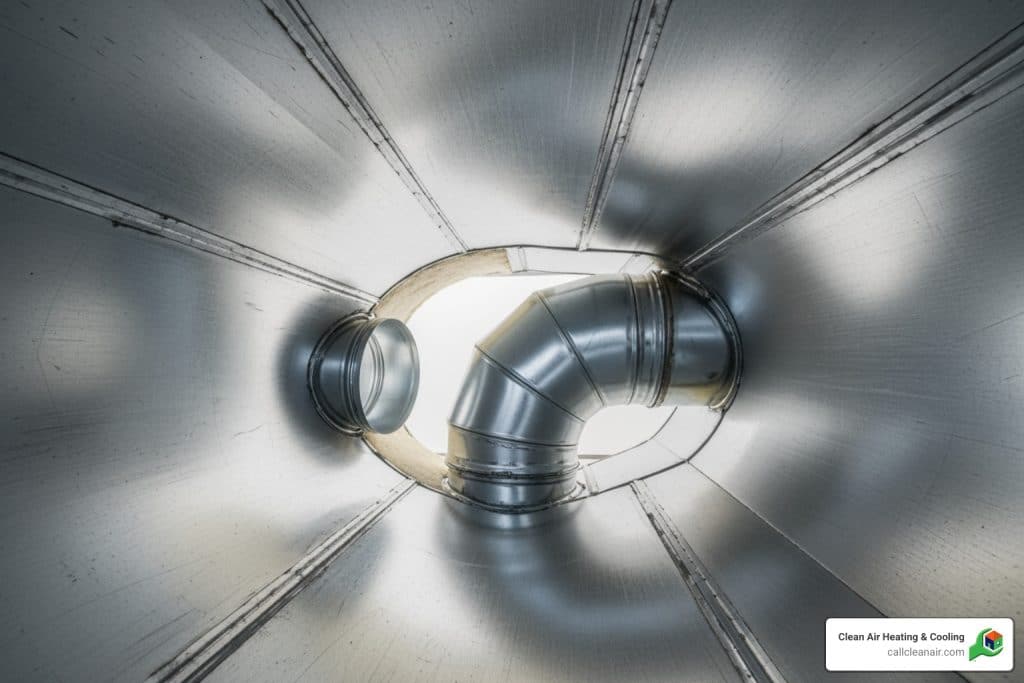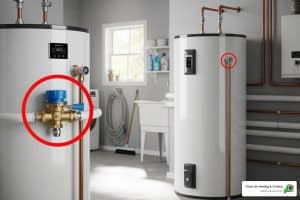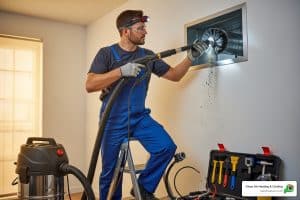Why Your Home’s Hidden Highway System Needs Regular Care
A clean air duct system is the foundation of healthy indoor air quality and efficient home heating and cooling. Your ductwork acts like the lungs of your home, circulating air throughout every room 5-7 times per day. When these pathways become clogged with contaminants, your entire living environment suffers.
Key components of air duct cleaning include:
- Supply and return air ducts – the main pathways for airflow
- Registers and grilles – visible vent covers in your rooms
- Blower motor and fan – equipment that moves air through the system
- Cooling coils and drain pans – components that can harbor moisture and mold
- Air filter housing – where your HVAC filter sits
The numbers tell a sobering story: a typical six-room home generates up to 40 pounds of dust annually just from everyday living activities. This dust, along with pet dander, pollen, and other contaminants, gets pulled into your HVAC system and recirculated throughout your home multiple times each day.
Common signs you need duct cleaning:
- Visible dust blowing from vents
- Unexplained allergies or respiratory issues
- Musty or stale odors when your system runs
- Recent home renovations or pest problems
As Colin Matei, owner of Clean Air Heating & Cooling, I’ve seen how a properly maintained clean air duct system can transform a family’s comfort and health. After years of serving Whatcom County homeowners, I understand that clean ducts aren’t just about air quality – they’re about creating a healthier, more efficient home for your family.
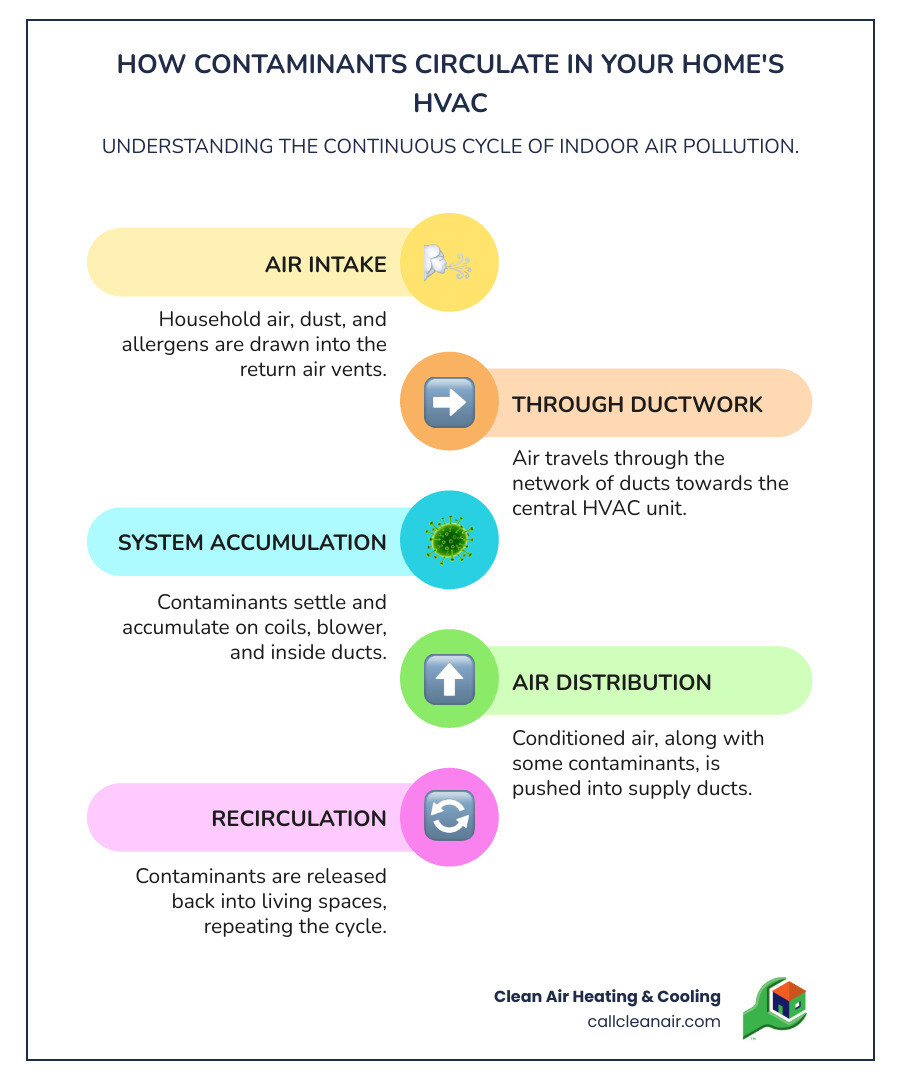
What Is Air Duct Cleaning and Why Does It Matter?
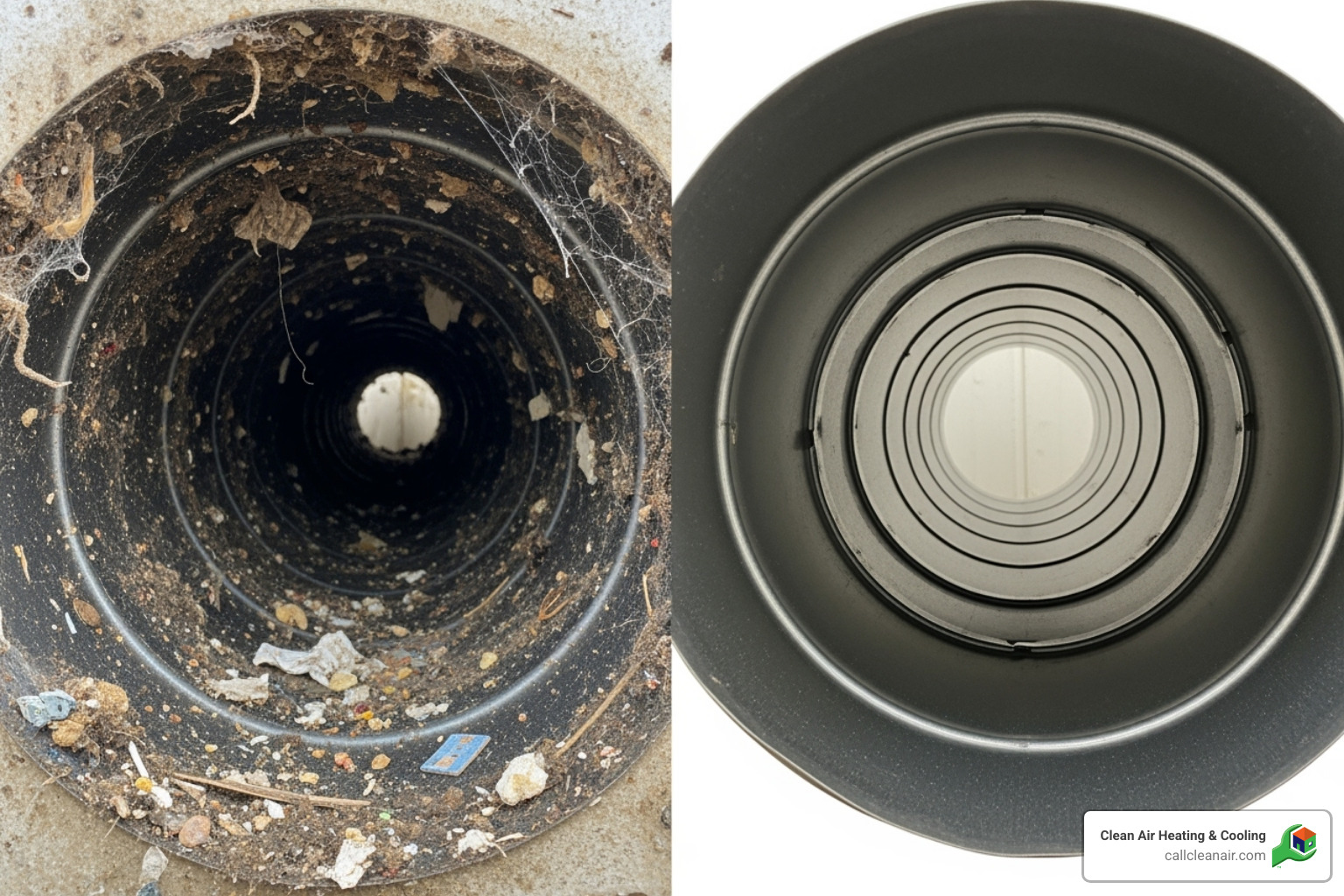
Here’s something that might surprise you: true air duct cleaning isn’t just about the ducts themselves. When we talk about creating a clean air duct system, we’re really talking about cleaning your entire HVAC system from top to bottom.
Think of it like washing your car – you wouldn’t just clean the windshield and call it good, right? The same logic applies to your home’s air system. If we only clean the ducts but leave the blower motor caked with dust or ignore moldy coils, those contaminants will just spread right back through your freshly cleaned ducts.
A comprehensive cleaning tackles every component where air flows and contaminants can hide. This includes your registers and grilles (those vents you see on your walls), the drain pan that catches condensation, and even the air filter housing. For homeowners who want to understand how all these pieces work together, our guide on HVAC System Checkup breaks it down in simple terms.
But why does all this matter for your family’s health and comfort? The answer lies in what’s actually lurking in those hidden pathways.
Dust and everyday debris might seem harmless, but when it’s constantly circulating through your home, it can trigger asthma and allergy symptoms. If you have pets, their dander joins this airborne party, creating a cocktail of irritants that can leave sensitive family members sneezing and wheezing.
The real concern, though, is mold and mildew. When moisture gets trapped in your system – whether from leaks, condensation, or high humidity – it creates the perfect breeding ground for mold spores. These tiny invaders can cause everything from respiratory issues to skin irritation, and they’re particularly troublesome for people with asthma. The CDC information on mold exposure provides detailed information about the health risks involved.
Your clean air duct system can also harbor volatile organic compounds (VOCs) from household cleaners, building materials, and other everyday products. Add in the possibility of pest infestations – yes, rodents and insects can make themselves at home in your ducts – and you’ve got a recipe for poor indoor air quality.
The good news? Professional cleaning removes these accumulated contaminants, helping create a fresher, healthier environment for your family. While clean ducts won’t cure existing health conditions, they can certainly help reduce the irritants that make respiratory issues worse.
Telltale Signs: When to Schedule a Duct Cleaning
Your home has a way of telling you when your clean air duct system needs attention. Much like a strange noise from your car, your HVAC system drops hints that it’s time for a professional cleaning.
Visible dust blowing from your vents is probably the most obvious red flag. If you see little dust bunnies dancing out of your supply registers or notice your vents looking like they haven’t been dusted in years, your ducts are definitely trying to tell you something.
Unexplained allergies or respiratory issues can be trickier to connect to your ductwork, but they’re often related. If family members suddenly start sniffling, coughing, or wheezing more than usual – especially when they’re at home – dirty ducts might be the culprit. It’s particularly telling if symptoms improve when you leave the house for extended periods.
Musty or stale odors circulating through your home when the system runs are another clear indicator. This smell often points to mold or mildew growth somewhere in your ductwork, which definitely needs professional attention.
Recent home renovations create a perfect storm for duct contamination. Construction dust and debris get pulled into your HVAC system and spread throughout your home. Even if contractors cover the vents, dust often finds a way in.
Pest infestations are nobody’s favorite findy, but if you’ve had unwelcome visitors like mice, insects, or other critters, they’ve likely left behind droppings, nesting materials, and other unpleasant surprises in your ductwork.
Finally, visible mold growth around your air ducts or HVAC components is a definite call to action. This is especially common around cooling coils or other areas where moisture tends to accumulate.
The EPA’s Stance on Duct Cleaning
The Environmental Protection Agency takes a measured approach to air duct cleaning recommendations. They’re honest about the fact that research on duct cleaning is still evolving, so they don’t offer blanket advice for routine cleaning.
However, the EPA does recommend considering professional cleaning when you have substantial visible mold growth inside hard surface ducts or on other HVAC components. If you have insulated ducts that are wet or moldy, they suggest replacement rather than cleaning.
They also recommend cleaning when your ducts are infested with vermin or when they’re clogged with excessive dust and debris that’s actually being released into your living space.
The EPA points out that minor dust accumulation often stays put on duct surfaces and doesn’t necessarily enter your home’s air. Their main focus for improving indoor air quality centers on moisture control to prevent biological growth and ensuring proper filtration.
For homeowners interested in energy savings, the EPA’s Energy Star website offers valuable information about duct sealing to reduce air leaks.
Determining Cleaning Frequency
While the EPA doesn’t endorse routine cleaning, practical experience suggests that most homes benefit from professional attention every 3 to 5 years as a general guideline.
Your specific situation might call for different timing, though. Homes with pets – especially multiple furry friends or heavy shedders – often need cleaning every 2-3 years. Smokers in the household also accelerate the need for cleaning.
Location matters too. Urban homes dealing with higher pollution levels might need attention every 2-3 years, while rural properties with cleaner outdoor air can often stretch to 4-5 years.
HVAC usage patterns play a role as well. If your system runs constantly year-round, it accumulates contaminants faster than systems used seasonally. Heavy usage typically means cleaning every 2-3 years makes sense.
Water damage or mold issues require immediate attention once the moisture source is resolved, with follow-up cleanings potentially needed every 2-3 years depending on severity.
The key is tailoring the frequency to your home’s unique environment and your family’s specific needs. A proactive approach to maintaining your clean air duct system pays dividends in comfort and health. For additional strategies to create a healthier indoor environment, check out our guide on how to Improve Indoor Air Quality.
The Professional Process for a Truly Clean Air Duct System
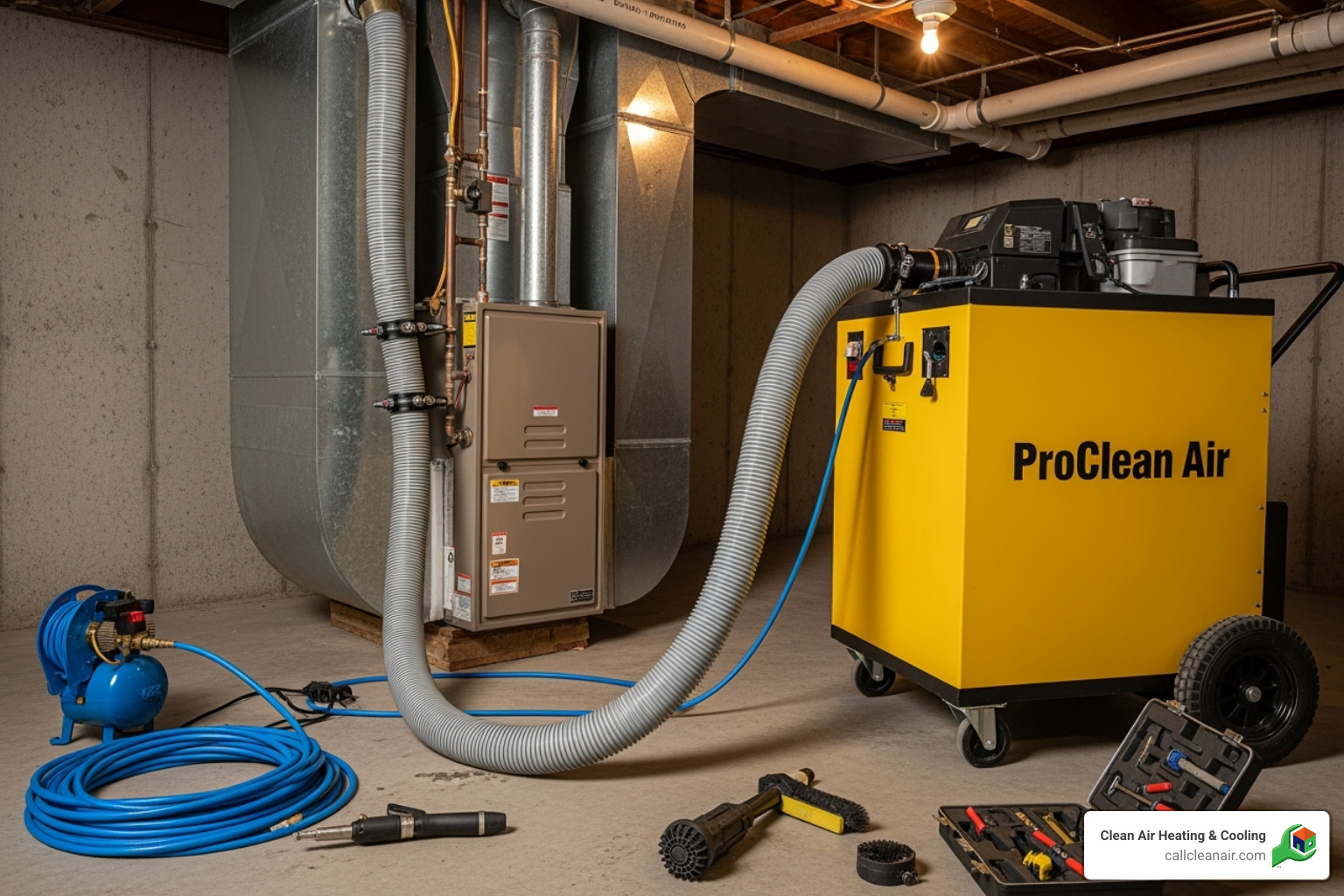
When you decide it’s time for professional duct cleaning, you’re not just getting someone with a bigger vacuum cleaner. You’re investing in a comprehensive process that transforms your entire HVAC system into a clean air duct system that works efficiently and safely.
The heart of professional air duct cleaning lies in what we call the source removal method. Think of it like performing surgery on your home’s respiratory system – everything needs to be contained, controlled, and methodically cleaned to prevent any contamination from spreading.
Negative pressure systems are the foundation of this process. We connect powerful vacuum equipment – often truck-mounted units that dwarf any household vacuum – to your HVAC system’s main trunk line. This creates continuous suction throughout your entire ductwork, essentially turning your ducts into a giant vacuum hose. The beauty of this approach is that nothing gets blown around your home during cleaning.
Once we have your system under negative pressure, the real work begins with agitation tools. We use specialized equipment like rotary brushes with long, flexible shafts that spin and scrub the interior surfaces of your ducts. Air whips use compressed air to blast stubborn debris loose, while compressed air nozzles provide precision cleaning for specific areas. It’s like giving your ducts a thorough scrub from the inside out.
The vacuum equipment we use features HEPA filtration that captures 99.97% of particles as small as 0.3 microns. This means even microscopic allergens, mold spores, and fine dust particles get trapped instead of floating back into your home’s air.
Professional technicians access your ductwork through system access points like existing registers and grilles. Sometimes we need to create small, temporary access holes in strategic locations to reach every section of your system. Don’t worry – we seal these openings properly afterward, ensuring your ducts remain airtight and efficient.
The process goes well beyond just the ducts themselves. We clean your blower motor and fan, cooling coils, drain pans, and other HVAC components. After all, there’s no point in having spotless ducts if your blower motor is caked with dust that will immediately recontaminate everything.
Why a Professional Clean Air Duct System is Superior to DIY
We get it – YouTube makes everything look easy, and there’s something appealing about tackling home projects yourself. But when it comes to air duct cleaning, the DIY approach often creates more problems than it solves.
Shop vacuums and leaf blowers – the most common DIY tools – simply don’t have the power to create proper negative pressure throughout your entire duct system. It’s like trying to empty a swimming pool with a drinking straw. You might move some surface debris around, but you’re not achieving the deep cleaning your system needs.
Without specialized agitation tools, you can’t effectively dislodge debris that’s adhered to duct surfaces over months or years. Most household equipment lacks HEPA filtration, which means you could actually be stirring up allergens and fine particles and releasing them into your living space.
The risks of improper cleaning go beyond ineffectiveness. You could damage flexible ductwork, disconnect joints, or create air leaks that reduce your system’s efficiency. Even worse, without proper containment, you might spread contaminants throughout your home, making your indoor air quality worse than before you started.
Professional technicians can also identify underlying issues like moisture problems, pest entry points, or damaged ductwork that a DIY approach would miss entirely. As experts recommend you don’t clean ducts yourself, the specialized training and equipment we bring to every job make all the difference.
For comprehensive and effective results, trust our professional Duct Cleaning Services to deliver the thorough cleaning your home deserves.
What to Look for in a Reputable Provider
Choosing the right air duct cleaning company can feel overwhelming, especially with so many options available. The good news is that knowing what to look for makes the decision much clearer.
NADCA certification should be at the top of your checklist. The National Air Duct Cleaners Association sets industry standards and trains technicians as Air Systems Cleaning Specialists or Ventilation Maintenance Technicians. When you see NADCA certification, you know the company follows established NADCA standards for proper cleaning procedures.
Proof of insurance protects both you and the workers in your home. Any reputable company will gladly provide documentation of their liability coverage without hesitation.
Written estimates should detail exactly what components will be cleaned and what the total cost will be. Be cautious of unusually low “teaser” prices that later balloon with hidden fees or high-pressure upselling tactics.
A trustworthy company avoids sweeping health claims about curing allergies or illnesses. While a clean air duct system can improve indoor air quality and reduce irritants, professional cleaners aren’t medical practitioners and shouldn’t make promises they can’t keep.
Look for transparency and evidence throughout the process. Reputable companies will show you the condition of your ducts before cleaning using inspection cameras, and they’ll demonstrate the contaminants they’ve removed afterward.
Be wary of companies that push routine chemical treatments or sealants without clear justification. The EPA and NADCA generally don’t recommend routine use of these products, and any biocides should only be applied after mechanical cleaning if microbial contamination is actually present.
Finally, confirm they plan full system cleaning rather than just running a vacuum through your ducts. As we’ve discussed throughout this article, effective cleaning requires addressing your entire HVAC system to prevent rapid recontamination.
When you ask these questions and look for these qualities, you’ll find a professional service provider who delivers a truly clean air duct system that improves your home’s air quality and efficiency for years to come.
The Tangible Benefits of a Clean Duct System

When I tell homeowners about the benefits of a clean air duct system, I’m not just talking about feeling good about having cleaner air. The benefits are real, measurable, and impact your daily life in ways you might not expect.
The most striking benefit? Energy savings. The U.S. Department of Energy has found that 25 to 40 percent of the energy used for heating or cooling a home gets wasted. Think about that for a moment – nearly half of what you’re paying for never actually makes it to keeping your family comfortable.
Dirty ductwork plays a major role in this waste. When dust, debris, and other contaminants clog your ducts, your HVAC system has to work significantly harder to push air through those narrowed pathways. It’s like trying to drink a thick milkshake through a straw versus drinking water – one requires a lot more effort.
This extra effort creates a reduced strain on your HVAC system when ducts are clean. Your furnace and air conditioner don’t have to fight against restrictions, which means less wear and tear on expensive components like the blower motor. When these systems can breathe easy, they last longer and need fewer repairs.
You’ll also notice better airflow throughout your home. Clean ducts allow conditioned air to move freely to every room, eliminating those frustrating hot and cold spots that make some rooms uncomfortable. The air reaches where it’s supposed to go, when it’s supposed to get there.
All of these improvements work together to create the potential for lower utility bills. When your system operates efficiently instead of fighting against dirty ducts, it uses less energy to achieve the same comfort level. Many of our customers are pleasantly surprised when they see the difference on their monthly bills.
These aren’t just nice-to-have improvements – they’re smart financial decisions that pay for themselves over time. To dive deeper into how these benefits unfold in real homes, check out The Benefits of Duct Cleaning.
How a Clean Air Duct System Improves Indoor Air Quality
The improvement in indoor air quality after professional duct cleaning is often the benefit homeowners notice most immediately. Since we spend about 90% of our time indoors, the air we breathe at home directly affects how we feel every single day.
Reduced allergens and irritants make the biggest difference for families dealing with allergies or respiratory issues. Over time, your ducts become a collection point for dust mites, pet dander, pollen, and mold spores. Every time your system runs, these particles get blown throughout your home, potentially triggering sneezing, coughing, or asthma symptoms. After a thorough cleaning, many families tell me their allergy symptoms improve noticeably.
You’ll also see less household dust settling on your furniture and surfaces. While some dust is inevitable in any home, a dirty duct system acts like a dust distribution network, constantly circulating fine particles that settle everywhere. After cleaning, most homeowners find they don’t need to dust as frequently, and their homes stay cleaner longer.
Perhaps most immediately noticeable is fresher smelling air. Cooking odors, pet smells, cleaning products, and even mustiness from mold can get trapped in your ductwork. When your HVAC system operates, these stale odors circulate throughout every room. Professional cleaning removes these trapped smells, leaving your home with genuinely fresh, clean-smelling air.
If you’re curious about exactly what’s floating around in your home’s air, we offer Professional Air Quality Testing to give you a complete picture of your indoor environment. Sometimes seeing the actual data helps homeowners understand why investing in a clean air duct system makes such a meaningful difference in their daily comfort and health.
Frequently Asked Questions about Air Duct Cleaning
You’re probably wondering about the practical details of getting your ducts professionally cleaned. As someone who’s been helping Whatcom County families for years, I hear these questions regularly, and I’m happy to share what you can expect.
How long does professional air duct cleaning take?
Most residential clean air duct system services take 2 to 4 hours to complete. Think of it like a thorough spring cleaning for your home’s airways – we want to be thorough, but we also respect your time.
Several factors can affect how long your cleaning takes. Larger homes naturally need more time since there’s simply more ductwork to clean. A cozy 1,200 square foot home might be done in 2 hours, while a sprawling 3,000 square foot house could take the full 4 hours or even a bit longer.
System complexity also plays a role. If your home has multiple HVAC units or particularly intricate ductwork with lots of twists and turns, we’ll need extra time to ensure every section gets properly cleaned. Homes with hard-to-reach ducts in crawl spaces or attics require more careful maneuvering.
The level of contamination makes a difference too. If it’s been many years since your last cleaning, or if you’ve had recent renovations, we might find more buildup than expected and need additional time to get everything spotless.
Will duct cleaning make a mess in my home?
This is probably the question I’m asked most often, and I completely understand the concern. The good news? A professional clean air duct system cleaning should leave your home cleaner, not messier.
We use negative pressure technology throughout the entire process. This means our powerful vacuum systems create suction that pulls all loosened dust and debris directly into our HEPA filtration units. Nothing escapes into your living spaces.
Our technicians take great care protecting your carpets and furnishings. We use drop cloths where needed, wear shoe covers, and treat your home with the same respect we’d want in our own. Any temporary access points we create in your ductwork are carefully sealed during cleaning to contain everything.
When we’re finished, we clean up completely. You’ll notice the fresh, clean feeling of improved air quality, but you won’t find dust bunnies hiding under your furniture or mysterious footprints on your carpet.
Is air duct cleaning worth the cost?
This question deserves an honest answer because I know you’re making a real investment in your home. While I won’t quote specific numbers, professional duct cleaning typically ranges from $450 to $1,000 depending on your home’s size and system complexity.
The cost versus benefits math often works in your favor over time. Statistic about 25-40% of your HVAC energy being wasted? When your system doesn’t have to fight through clogged ducts, it runs more efficiently. Many of our customers notice lower utility bills within a few months of their cleaning.
There are also long-term savings to consider. Clean systems put less strain on expensive components like your blower motor and heat exchanger. When these parts don’t work overtime pushing air through dirty ducts, they tend to last longer, potentially saving you thousands in premature replacement costs.
The health considerations can be invaluable, especially if anyone in your family deals with allergies or respiratory issues. While we can’t promise medical miracles, many customers tell us they breathe easier and feel more comfortable at home after their cleaning.
Think of it this way: you wouldn’t drive your car for years without changing the oil. Your home’s clean air duct system deserves similar attention to keep everything running smoothly and efficiently.
Your Next Steps to a Healthier, More Efficient Home
Now that you understand how a clean air duct system transforms your home’s air quality and energy efficiency, it’s time to put that knowledge into action. The journey from dusty, contaminated ducts to fresh, clean air doesn’t end with a single professional cleaning—it’s about creating lasting habits that keep your home healthy.
Think of maintaining your ducts like tending a garden. You wouldn’t plant beautiful flowers and then ignore them for years, right? Your HVAC system needs the same ongoing care to flourish.
Start with the simple stuff that makes a big difference. Changing your HVAC filters regularly is like giving your system a fresh breath every few months. Most filters need replacing every 1-3 months, depending on your home’s specific conditions. If you have pets or someone with allergies, you might need to change them more often.
Cleaning your registers and grilles is another easy win. A quick vacuum or gentle wipe-down every month prevents that telltale dust buildup you see around vents. It takes just a few minutes but keeps surface contaminants from getting pulled deeper into your system.
Controlling humidity levels is especially crucial here in the Pacific Northwest. Our damp climate can create perfect conditions for mold growth in ducts. Keep indoor humidity between 30-50% using dehumidifiers, exhaust fans, and proper ventilation.
For homeowners who want to take the guesswork out of maintenance, our HVAC Maintenance Plans provide comprehensive care that keeps your entire system running smoothly year-round. Regular professional maintenance catches small issues before they become expensive problems.
Here in Whatcom, Skagit, and surrounding counties, we understand the unique challenges our climate presents. That’s why Clean Air Heating & Cooling has earned over 480 five-star Google reviews—we know how to keep Pacific Northwest homes comfortable and efficient. Our 25% utility savings guarantee reflects our confidence that proper HVAC care really does make a measurable difference in your energy bills.
Don’t let another season pass with contaminated ducts compromising your family’s comfort and health. Whether you’re in Bellingham, Mount Vernon, or anywhere across Whatcom, Skagit, Snohomish, or San Juan Counties, we’re ready to help you achieve that clean air duct system your home deserves.
Ready to breathe easier? Contact us today for your Duct Cleaning Mount Vernon WA service, or wherever you’re located in our service area. Your lungs—and your wallet—will thank you.

